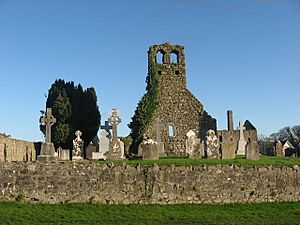Monknewtown facts for kids
|
Baile Nua na Manach
|
|

Ruined medieval church at Monknewtown and graveyard
|
|
| Location | valley of the River Boyne |
|---|---|
| Region | County Meath, Ireland |
| Coordinates | 53°43′16″N 6°29′17″W / 53.721°N 6.488°W |
| Type | henge, ritual pond |
| Part of | Brú na Bóinne |
| History | |
| Periods | Neolithic |
| Type | Cultural |
| Criteria | i, iii, iv |
| Designated | 1993 (17th session) |
| Part of | Brú na Bóinne - Archaeological Ensemble of the Bend of the Boyne |
| Reference no. | 659 |
| Ireland | |
| Region | Europe and North America |
Monknewtown (which means "new town of the monks" in Irish) is a special place in County Meath, Ireland. It's about 3 kilometers east of a town called Slane. Long ago, it was known as Rathenskin.
Monknewtown is located on the right side of the Mattock River. This river was important because it powered old watermills nearby. It also forms the eastern border of Monknewtown with other areas like Keerhan and Sheepgrange.
Contents
What is a Townland?
A townland is a small area of land. It's like a tiny neighborhood or division of land in Ireland. Monknewtown is one of these historic townlands.
Location and Surroundings
Monknewtown has many neighbors! To the south, you'll find Balfeddock, Knowth, and Crewbane. To the west are Cashel, Mooretown, and Knockmooney.
The northern edge of Monknewtown is marked by a small stream that flows into the Mattock River. The southern edge is bordered by the N51 road. Most roads in Monknewtown are small, local paths.
River Crossings
In the northeastern part of Monknewtown, there's a ford across the Mattock River. A ford is a shallow place in a river where people and animals can walk or drive across. This ford connects Monknewtown with Keerhan.
Connection to Ancient History
Monknewtown is very close to a famous ancient area called Brú na Bóinne. This whole area is a World Heritage Site, which means it's recognized as super important globally. Brú na Bóinne includes the amazing site of Newgrange.
Monknewtown itself has two important Neolithic sites. The Neolithic period was a time in history when people started farming and building large monuments. This was a very long time ago!
The Ritual Pond
One of the sites is a "ritual pond." A ritual means a special ceremony or action. This pond was likely built later in the Neolithic period. It has an earth bank about 2 meters high that forms a circle. This circle is about 30 meters wide and is filled with water.
The Henge
The other important site is a henge. A henge is a type of circular earthwork. It usually has a bank and a ditch. These sites were often used for special gatherings or ceremonies by ancient people.
Historians believe these sites at Monknewtown might have been used for important activities. They could have been part of ceremonies connected to the large tombs and other special places found in Brú na Bóinne.


